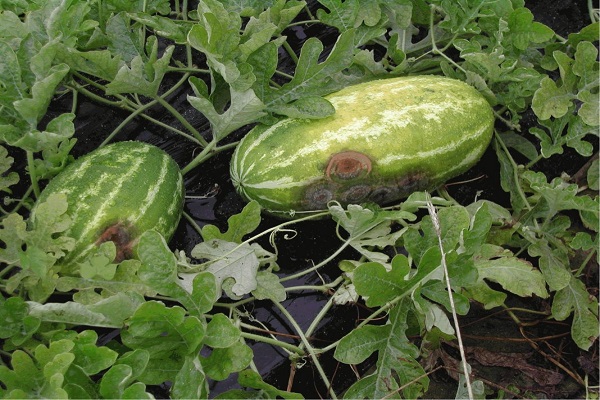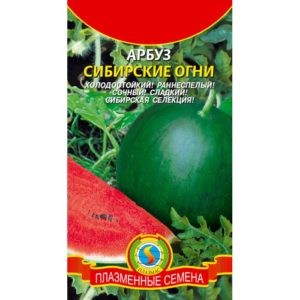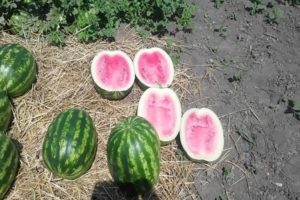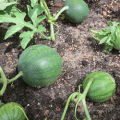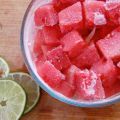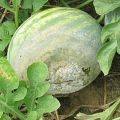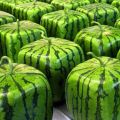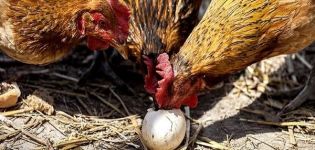Are there watermelons with yellow pulp inside, what is the name of the variety and the characteristics of cultivation
With the onset of summer, many can finally get their fill of watermelons. Most of the varieties of watermelon sold in the markets are characterized by a sugary red flesh. But recently, you can see the yellow watermelon. For many people, such watermelons are a gimmick, and not everyone is ready to accept that the watermelon is not a classic red shade, but an unusual yellow. But yellow fruits are no worse than their classic counterparts.
Content
Yellow watermelon: description and characteristics
The peculiarities of a yellow watermelon, first of all, are in the shade of ripe pulp. This hybrid was first obtained in Thailand by crossing an ordinary watermelon with a wild one. The hybrid has a high content of carotenoids, which is why the pulp has such a shade.

The varieties grown in their homeland, Thailand, have a very sweet taste. These fruits have a high amount of sugar in the pulp. Fruits grown in other countries are less sugar-rich in taste. The skin of the fruit pulp is thin, but firm. Some varieties have a peculiar flavor of lemon, pumpkin, mango and other fruits and berries.
How do they differ from red
Yellow watermelons differ from red varieties in pulp. And besides this, another characteristic difference is taste. Yellow watermelons, which are grown on the territory of the Russian Federation, have a pumpkin flavor. Also inside, in the pulp, there are fewer seeds than in the red variety. Yellow-fruited berries are smaller in size, and rarely grow more than 10 kilograms. Otherwise, the taste of yellow fruits is no different from red ones.
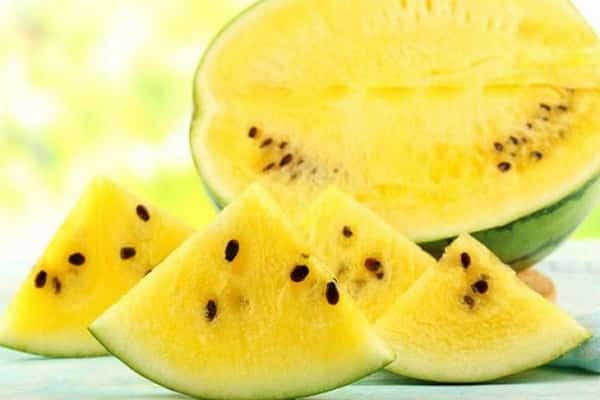
Popular varieties
Breeders have developed several varieties of yellowish watermelon that can be grown in southern regions. What are the varieties of melons with yellow pulp:
- Prince Hamlet is a berry that was bred by breeders from Russia. The peel is green with light green stripes. The pulp tastes like pineapple. The growing season is up to 75 days.
- Golden Grace - the fruit was bred by breeders from Holland. The maximum weight is 8 kilograms. Differs in resistance to frost.
- Lunny is the most widespread variety in Russia. Fruit ripening period ranges from 70 to 80 days. Some people note that the pulp has a mango and lemon flavor.
There are not so many varieties of yellow berries in Russia. They can be successfully grown only in the south or, in extreme cases, in the central regions.
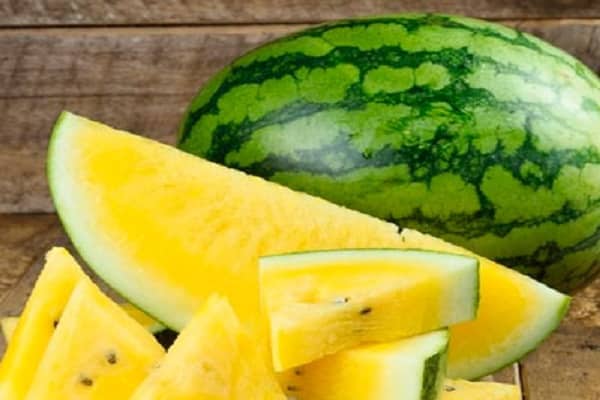
Growing rules
Growing yellow watermelons is no different from traditional reds. Particular attention is paid to planting seeds and growing seedlings.In general, the berry belongs to crops that are unpretentious in care.
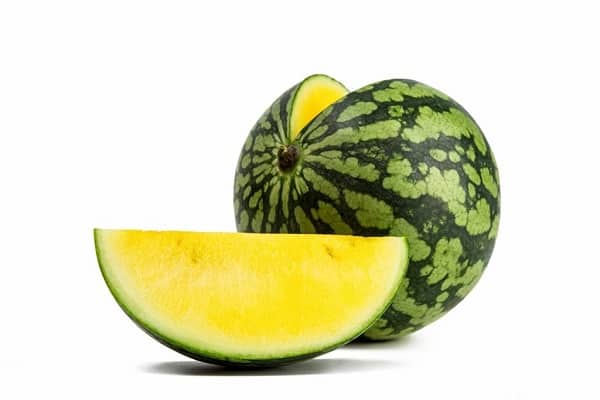
Seed preparation
In order to successfully grow melon seedlings, you need to pay special attention to the preparation of seeds.
Seed preparation stages:
- First you need to pack the seeds. Healthy and strong seeds are suitable for planting.
- The second stage is the heating of the planting material. Water is poured into a saucer, at a temperature of 50 degrees, and seeds are placed there. After 30 minutes, the water is drained.
- After warming up, the planting material is disinfected. A small amount of potassium permanganate is diluted in water, then the seeds are placed in the solution and left for 15-20 minutes. Then washed with water.
- After disinfection, the planting material is germinated. For this, water is poured into a saucer, seeds are placed there and covered with polyethylene. After a few days, sprouts appear.
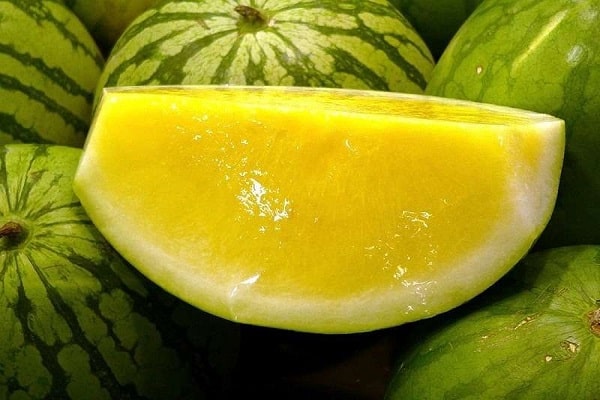
All these measures contribute to the acceleration of emergence after planting seeds.
Sowing and growing seedlings
Young seedlings are very capricious and require increased attention. As you know, melons and gourds are characterized by a weak root system and do not tolerate transplantation well. Therefore, sowing seeds is given as much attention as possible. For planting, use the following containers:
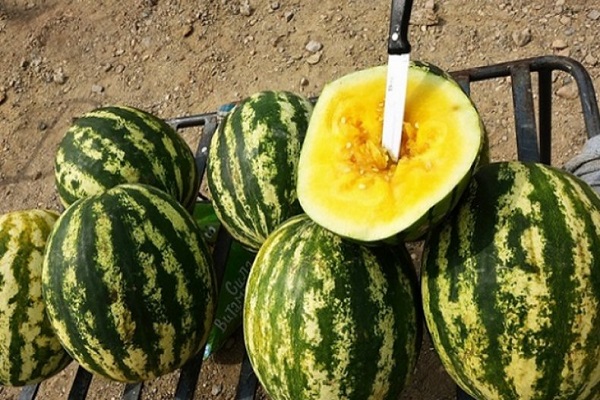
- peat cups;
- carton boxes;
- peat tablets;
- wooden boxes;
- plastic glasses.
The soil mixture is made up of humus and peat-humus soil in equal parts. A tablespoon of wood ash is added to the soil mixture.
The seeds are planted in separate cups after the sprouts have hatched. Then they cover it with cling film and put it in a warm room, where the temperature will be about 30 degrees. For example, south windows. Periodically, the film is removed, checked for mold, and watered with a watering can.

Landing in open ground
After the seeds have sprouted, they are planted in the soil. The holes are dug to a depth of 5 centimeters. The hole diameter must be at least 50 centimeters. The distance between each hole is left up to 70 centimeters.
Before sowing seeds, the soil is dug up and mixed with rotted manure. It is not recommended to use fresh manure, it is concentrated, and can burn the roots of young seedlings. In addition, complex mineral fertilizers are applied to the soil.
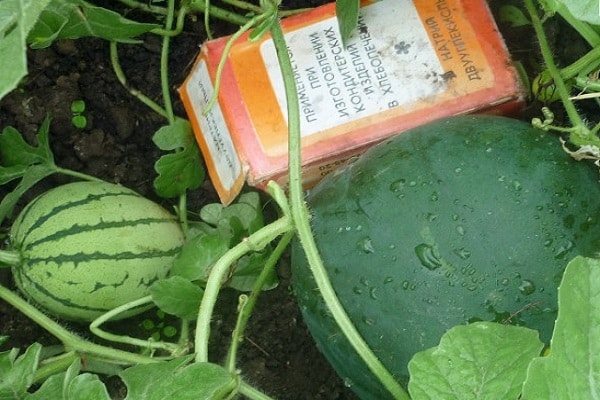
Care, watering and feeding
In watermelons, the root system grows to a depth of 70 centimeters, so the bushes need abundant watering. If a heavy rain has recently passed, then watering should be postponed for several days. Bushes do not like waterlogging of the soil. The beds are watered with a hose. Watering is carried out in the evenings when the sun goes down. Most of the liquid is required for the bushes during growth and during the flowering period, as well as the formation of ovaries.
Before watering, once a week, you should loosen the soil so that, along with moisture, the root system is saturated with oxygen.
In order to increase the yield, you need to regularly make organic and mineral fertilizing.

- In the first 4 weeks after planting seedlings in open ground, potassium is used. Potassium promotes abundant flowering and ovary formation. In addition, potassium increases the resistance of plants to diseases.
- From 4 to 7 weeks, magnesium and calcium are added to the bushes. Calcium and magnesium increase the content of ascorbic acid in fruits, as well as sucrose.
- From 8 to 12 weeks, nitrogen is introduced into the soil. Nitrogen fertilizers promote active growth of ovaries.
After the fruits begin to form, the bushes stop watering and fertilizing.
In addition to mineral dressings, yeast solutions are used for plant growth. To prepare the fertilizer, 2 tablespoons of sugar and 45 grams of yeast are diluted in 1 liter of water. Insist 2-3 days. Before watering, fertilizers are diluted with water and the bushes are watered at the root.
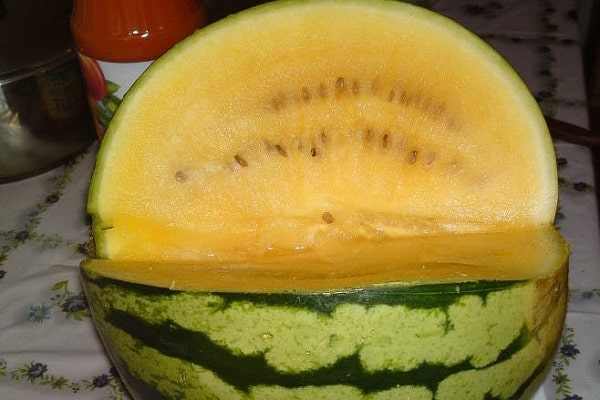
Harvesting
Harvested yellow watermelons at the same time as the varieties with red pulp. To determine the maturity of watermelons, it is enough to pay attention to a number of signs:
- You need to knock on the watermelon. If the sound is muffled, then the fruit is ripe and needs to be cut.
- The stalk dries up.
- If a yellow spot remains at the point of contact between the peel and the ground, then the watermelon is ripe.
- A ripe watermelon, when pressed on the peel, does not leave dents.
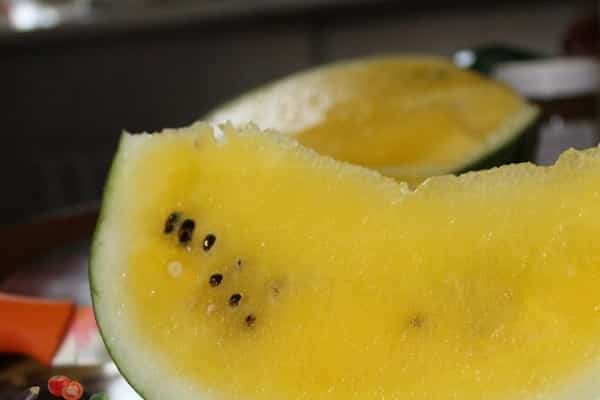
Harvesting begins in August (in the southern latitudes). In the central regions, the term for picking berries depends on the variety and climatic conditions. During the cut, a stalk is left, 5 centimeters long.
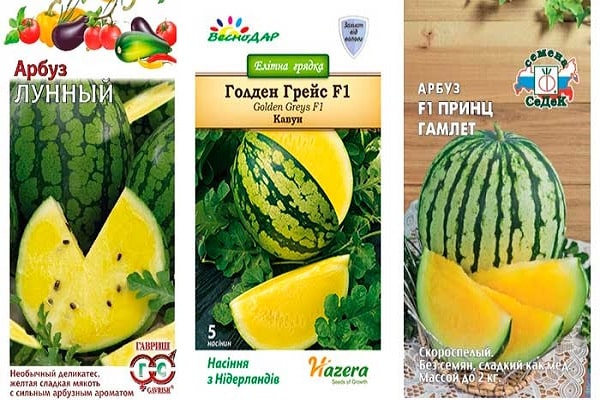
What diseases and pests are dangerous for this species
Pests and diseases in yellow varieties are the same as in red watermelons.
- The first sign of fusarium is the appearance of orange spots, which gradually become covered with pink bloom. As the fungi spread, the stems and leaves begin to rot, and the bush itself stops growing.
- Another disease is anthracnose. The disease is characterized by the appearance of brown spots on the foliage. Then the spots will spread to the fruit. Watermelons stop growing and rot.
- Root rot is characterized by the appearance of black-brown spots near the root base and on the stems. The reason for the development of root rot is high humidity, temperature difference between day and night, as well as an excess of nutrients in the soil.
- Bacterial spot is caused by insects. First, weeping spots of yellow-green color appear on the watermelon. They gradually increase. Growths appear on the fruits. The leaves turn black, and the bushes themselves wither.
- Powdery mildew is characterized by the appearance of a white coating on the leaves. The fruits become deformed and start to rot. The cause of powdery mildew is a fungus.
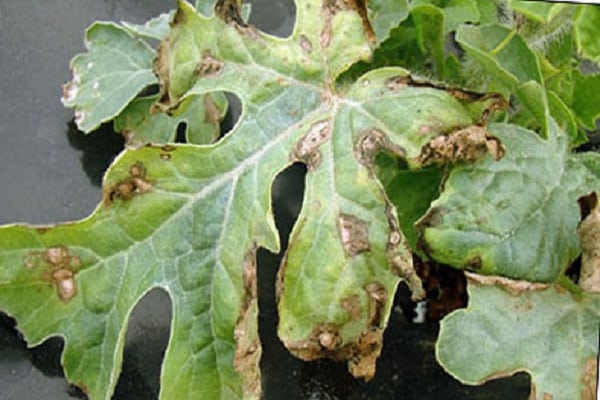
Among the insects that are found on watermelons are:
- melon aphids;
- wireworm;
- spider mite;
- thrips.
In order to prevent the appearance of insects and diseases on plants, you need to pay attention to caring for watermelons. Many diseases cannot be cured, therefore it is necessary to prevent diseases and the appearance of melon pests immediately.
